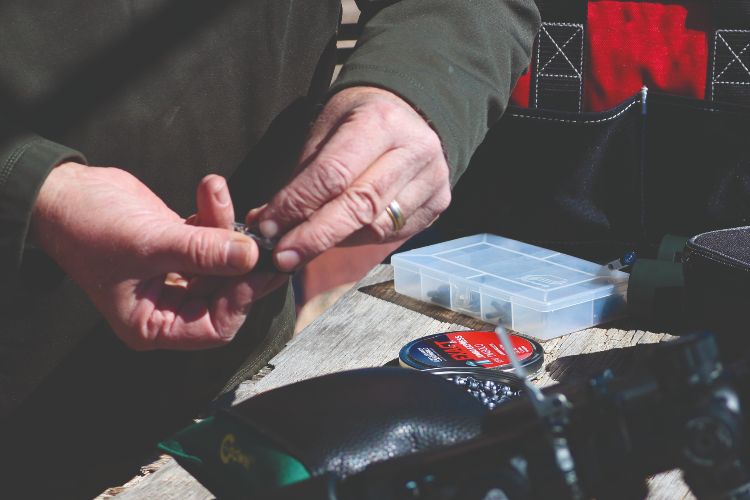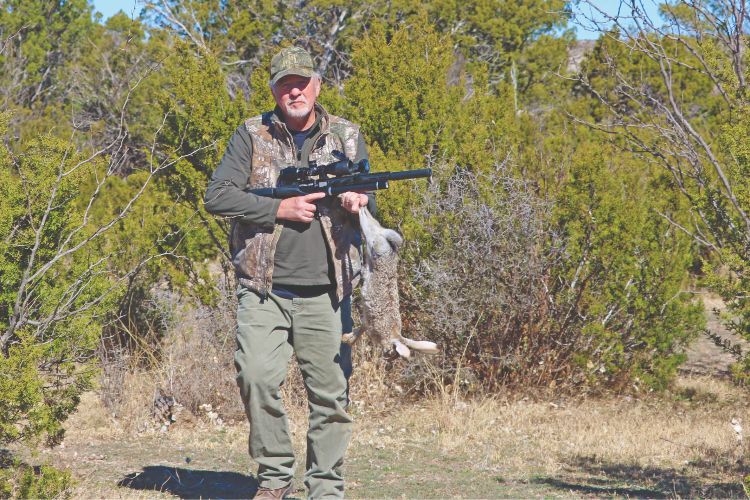I’m sitting in the bunk house at the ranch, a few days into my trip to West Texas, writing up the experience gained with a new gun I’ve been getting to know, the Umarex NOTOS CRK. After a few days of stalking javalina through some pretty rugged terrain, with big bore air rifles, the thought of an easy stalk on jackrabbits – a large desert hare, actually – sounded like the perfect opportunity to try out the Umarex NOTOS CRK on small game.
I’d been on my own the first couple days until my buddy, Chacho, and his dad, Valente, arrived for the weekend. It’s always good to catch up with friends you don’t see too often, and we try to meet up a couple times a year for a deer or predator hunt. I get so focused on hunting that I sometimes neglect things, and on this trip, it was food. I’d tossed some hotdogs and diet coke into the ice chest on the way, and had been living on hot dogs for breakfast, lunch, and dinner, but Valente is a great camp chef, and they’d brought ribs to barbecue, and the makings for tostadas, enchiladas, and huevos con chorizo. I’d felt like I’d been rescued!
ON THE RANGE
Whilst they got themselves situated at the bunkhouse, I set up at the range to sight in my gun and test several pellets to determine which I should hunt with. I threw the compact little .22 carbine on a sandbag and cycled through several brands, weights, and configuration of pellets, and found to my surprise that almost everything I threw at the gun grouped fairly well, generating sub-inch groups under difficult conditions. In the end, I decided to use the JSB Exact 14.4 grain round-nose pellets because they were consistently accurate, and I have a lot of confidence in their terminal performance.
 The 7 shot magazine is simple to load, and extras are inexpensive
The 7 shot magazine is simple to load, and extras are inexpensive
The NOTOS appealed to me on several levels as a small-game gun, at least on paper; it is very compact with an adjustable stock, overall length of 31 inches (stock collapsed) and weighs in at 4lbs; it has a 7-shot magazine, sidelever action, an integrated sound suppression system, and utilises a pre-set (1900 psi) regulator that should deliver consistency. Of course, my intention on that first range session was to prove that the reality met the promise of the published specifications. What I found was that at 40 yards in howling winds, I could place pellet after pellet into the kill zone of a jackrabbit whilst shooting off sticks. I also measured a 21-shot string over the chrony with the JSB Exact that demonstrated a 10fps variation, shrinking to 6fps if I discarded the last two shots. The average velocity was 760fps for 18fpe with the Exacts, exceeding the Umarex claims, which is a good thing here in the States. I expect Umarex will ensure that the guns are tuned to be legal limit where that is required. In an impromptu plinking session at steel spinners, I was knocking them around, shooting off-hand at 30 yards, and really liked the way the little gun handled.
ON THE HUNT!
The ranch covers miles of land that is constantly changing, from flat sparse desert plains to rocky hills and cliffs, to cedar thickets, but I’ve found that jackrabbits prefer the slightly more open areas mixed in with sparse cedars, where they can use their hearing and speed to stay away from danger. The way I hunt them is either to drive the washboard dirt roads, or hike through the brush, looking for a rabbit on the move or locating them in a scrape, then stalking in for the shot. This is challenging because whilst these hares can put distance between you very quickly, they will frequently sneak through the brush and try to get behind you before bolting. It sometimes seems as though they’ve vanished into thin air.
Jackrabbits and cottontails are cyclic; in some years being so densely populated you almost seem to trip over them, to periods in which the populations crash. This depends on rainfall, temperatures, disease, and predation from coyotes, bobcats, hawks, owls, and eagles. When populations are exploding, jackrabbits can have a real impact on the marginal grazing because this is a working ranch. At these times, we might shoot 30 or 40 in a day, sometimes more. However, right now, the populations are lower, so I tend to limit myself to bagging a couple on a hunt. These hares are frequently over 7-8lbs, so that still represents a lot of chili con conejo in the crockpot!
DON’T LOOK BACK!
I spotted a jack bedded down in a scrape at the base of a stunted palo verde, but couldn’t find a way to thread a shot through to him. He was about 25 yards away, and there was no easy approach to angle into a better shooting lane. As I stood tucked into the branches of a stunted tree, the rabbit jumped up and bolted. I’m not sure why, he didn’t hear me because I remained very still, and I don’t think he could see me, although I guess if I could see him, he might be able to see me.
I took off, following, keeping the tree he ducked behind between us. Just as I stepped out of cover, the rabbit took off from a spot 20 yards to my right. I hadn’t even seen him move that way, and it seemed he was circling away, but jackrabbits have a bad habit, they are so sure of their speed that they will stop to look back at the threat – and that is exactly what this rabbit did at 35 yards, when my off-hand shot found its mark, dropping him on the spot.
I walked over and collected a big fat hare, then started walking him back to the truck. Along the way, I bumped another rabbit that I chased through the brush for about a half hour before finally getting into a shooting position, but when I looked through the scope, I noticed it was a chunky doe looking like she was about to produce the next generation, so I gave her a pass. I am the only one that hunts rabbits or hares on this property, so when the numbers are running high, I view this as pest control and focus on culling the numbers, but when populations are lower, I’ll take a few for the table and mostly leave them to recover. On the way back, I noticed a couple whitetail deer standing in the brush watching me, and it reminded me that I’d be back at the end of the year to fill the biltong box!
 Packing out my quarry, these hares get big!
Packing out my quarry, these hares get big!
THE NOTOS CRK
So, what did I think about the NOTOS? Well, first off, the gun is a lot of fun to shoot! The stock is quite ergonomic and was easy to adjust for a good fit. The sidelever is on the left side and can be cycled without breaking the cheek weld. The trigger is not adjustable, a medium pull weight, and a bit of slop, serviceable but not great. Whilst the action is not overly refined, it is functional and permits accurate shooting; I might complain if the NOTOS cost two or three times more, but at the price point where it sits, I find it better than expected. The 7-shot magazines are lightly constructed plastic, but they function reliably, and extra magazines are inexpensive. I found the single-shot tray useful when shooting the longer polymertipped pellets. There is no recoil with this little .22, and it is very quiet. From a performance point of view, this is a solid small game gun that provides three full magazines on a fill.
Is it the ultimate budget hunting gun? I’m not saying that I’d replace my primary hunting rifle with a NOTOS, but it makes for what we call, a great little ‘truck gun’. I can see myself tossing this in my kayak when paddling off for a weekend of fishing, or keeping it in the boot of my SUV for an opportunistic squirrel hunt. I also think it’s a great youth rifle that won’t be quickly outgrown as a young shooter gains experience. It’s not a target gun by any means, but one of the most fun plinkers that I’ve shot in a long time!
